After successfully advocating for pedestrian safety and walkability projects to be included in a county-wide bond package (which later failed at the ballot box) Tucson’s Living Streets Alliance capitalized on the momentum to pursue a Complete Streets policy as another way to make the city’s street safer and more accessible. Over three years, working in close collaboration with the City of Tucson Department of Transportation and Mobility, they involved community members, city staff, and subject matter experts to write a policy that had widespread support, included strong language, and was easy to quickly implement.
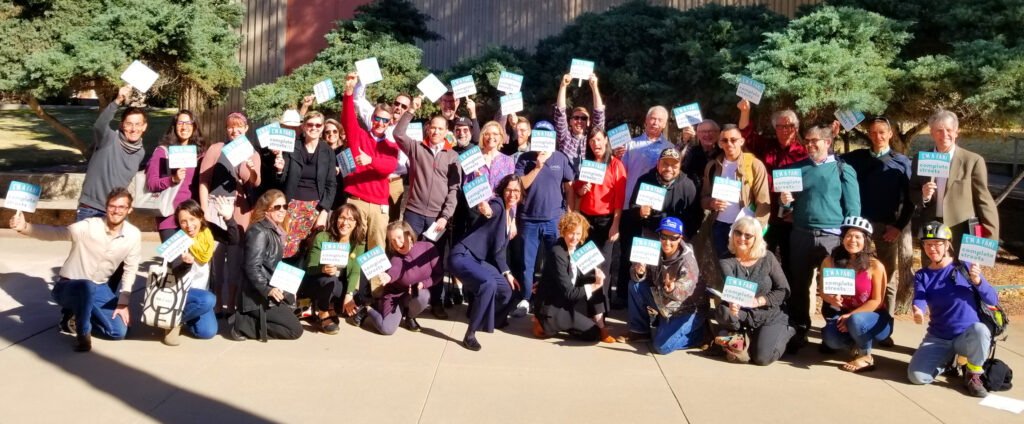
Supporters and members of Living Streets Alliance outside of the city council chambers after a Complete Streets agenda item was discussed, posing with signs in support of Complete Streets.
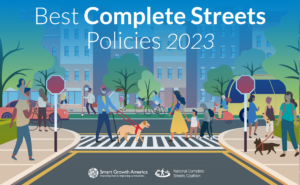 This story is one of four features pulled from the Best Complete Streets Policies 2023. Profiling four communities with some of the strongest policies, each story goes into detail about how that specific policy was developed, why it scored so highly, and how everyone involved navigated the barriers on the way to adoption.
This story is one of four features pulled from the Best Complete Streets Policies 2023. Profiling four communities with some of the strongest policies, each story goes into detail about how that specific policy was developed, why it scored so highly, and how everyone involved navigated the barriers on the way to adoption.
Read the full report and other case studies at smartgrowthamerica.org/best-complete-streets
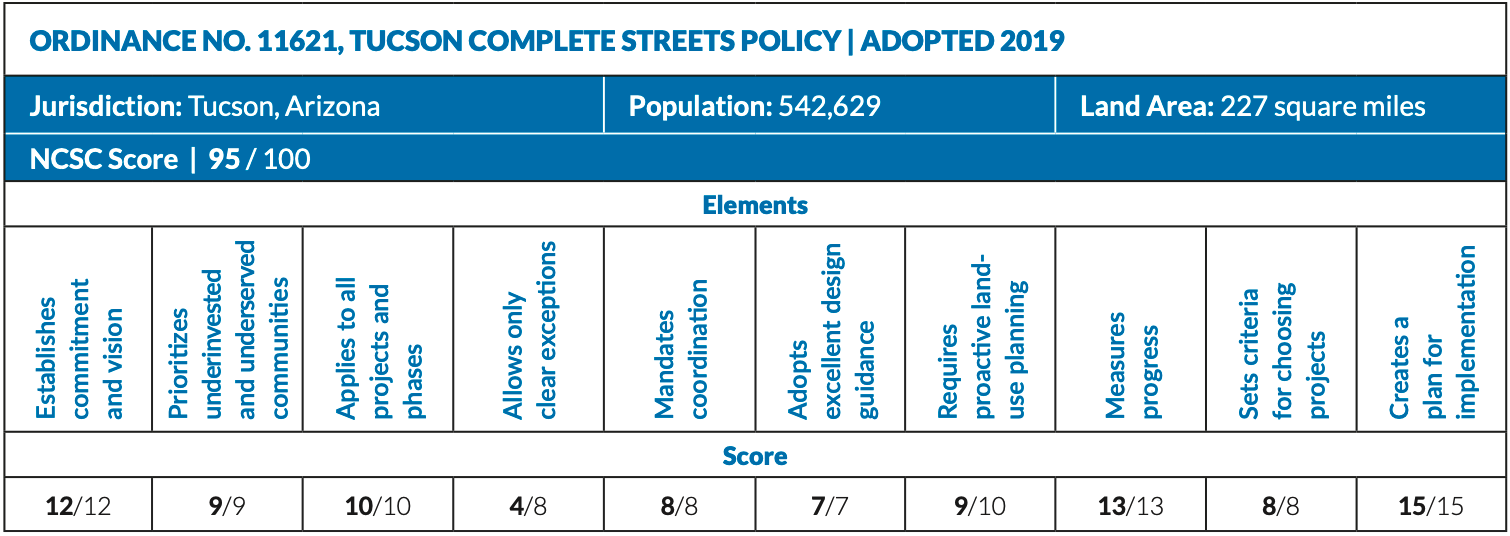
View the ordinance and policy text.
Part I: Background
A city of over half-a-million people, Tucson, Arizona lies just over 100 miles southeast of Phoenix in Pima County, between the state’s capital city and its southern border with Mexico. It is home to the University of Arizona’s main campus, its non-white Hispanic/Latinx population makes up 44 percent of the city, and the median household income is $43,425.
Tucson’s Complete Streets journey started in the early 2010s with the Living Streets Alliance (LSA), but LSA’s initial goal wasn’t to write a Complete Streets policy. The organization was initially formed by a group of advocates who recognized that there was a disconnect between what people wanted to see on their streets and what was getting built. The founding members were also inspired by and wanted to expand on the city’s very first Cyclovia, now a bi-annual event where select streets are temporarily made car-free. In 2012, shortly after being formed as an organization, LSA launched a Pedestrian Safety & Comfort Campaign with the goal of “making the simple act of walking safe, comfortable, and convenient in the greater Tucson region.” One of the strategies identified in the campaign was to create a funding source for pedestrian infrastructure improvements.
To help achieve this, LSA turned its attention to a county-wide bond measure in 2015 and forged numerous partnerships to successfully advocate for funding to be allocated in the bond package for pedestrian safety and walkability projects. Although this bond measure failed, the energy created around it expanded their coalition and drew supporters together for a Community Walking Forum in 2016. At that forum, attendees decided to pursue a Complete Streets policy. Less than three years later, there was a Complete Streets policy on the books in Tucson. So how did they get from Complete Streets not being fully on their radar to passing one of the stronger policies that we scored and receiving national attention for their policy, including a Complete Streets Gold Medal from CityHealth?
Watch a video we produced with CityHealth in early 2022 about the Complete Streets efforts in Tucson, featuring some of the people included in the piece below.
Part II: Road to Adoption
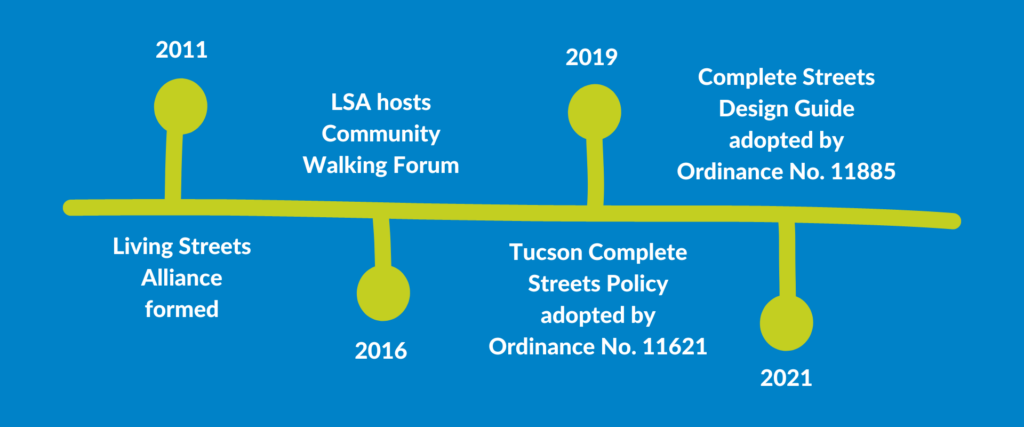
Tucson’s Complete Streets policy was unanimously adopted by Mayor Regina Romero and the City Council in February 2019. Crafting such a policy requires work and time, which typically means money. Thankfully, a chance encounter with the then- Director of the National Complete Streets Coalition, Emiko Atherton, helped LSA learn about grant opportunities from Voices for Healthy Kids. After securing this funding, the organization was able to support staff and engage the resources necessary to work closely with both the public and city staff to deliberately develop Tucson’s policy from the ground up over those next three years.
LSA’s first step was bringing together a diverse group of stakeholders—individuals from city agencies and external organizations covering topics like affordable housing, public transit, disability rights, green infrastructure, and food justice—to guide their outreach efforts and initial frameworks for the policy and serve as the city’s Complete Streets Task Force. The task force grew out of an earlier and smaller body, referred to by Evren Sönmez, LSA’s Director of Strategic Policy and Practice, as a “brain trust.” The brain trust helped LSA think through how to get started with a Complete Streets policy and center it around equity. The task force helped craft the policy and also became a sounding board, weighing in repeatedly on drafts of the policy prepared by LSA and city staff in order to iterate and steadily improve the policy.
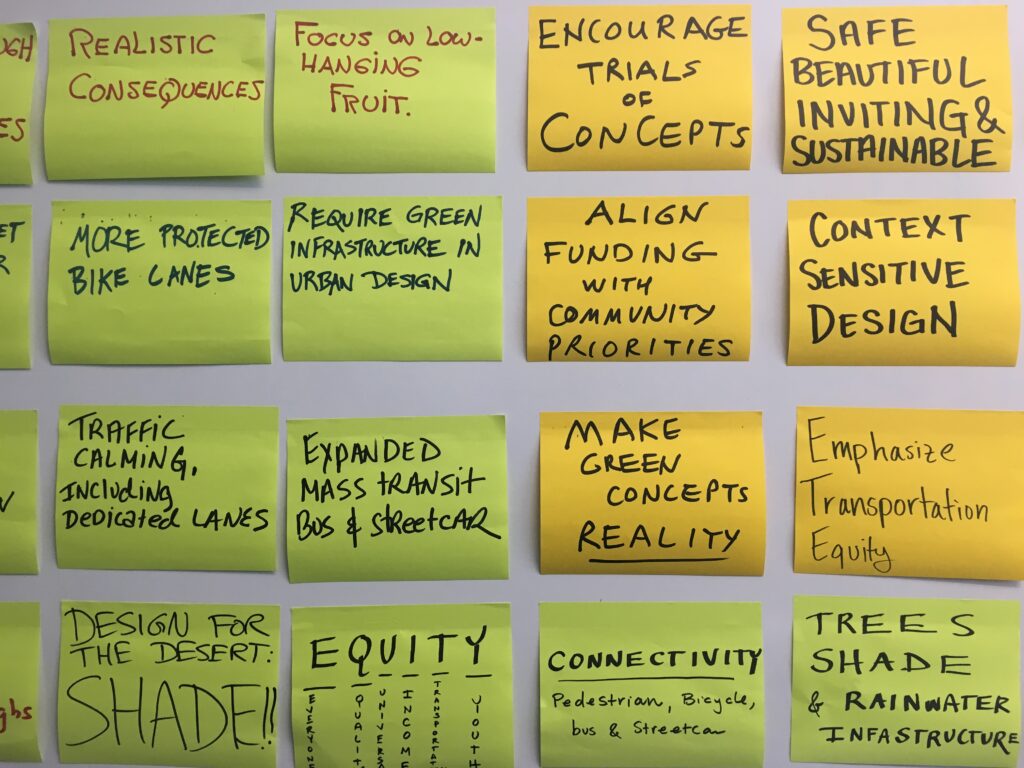
Simultaneously, LSA engaged the broader community to ensure that lived experience shaped the policy in addition to formal credentials. Through working with process design consultants, LSA developed a “Rethinking Streets” workshop built upon an “appreciative inquiry approach” and hosted a series of workshops with various neighborhood and community groups. During these workshops, participants collaborated to articulate their vision for Tucson’s streets and arrive at shared themes and recommendations to help guide the policy. This approach integrated the critical expertise each community member brought to the conversation and broader movement.
This collaborative process also ensured that broad swaths of the community—whether they were an engineer employed by the city or somebody who showed up to a meeting having never heard of Complete Streets—actually held a stake in the policy. Although time- consuming, the extensive outreach that accompanied the policy’s development built relationships that helped affirm that investing in safer streets was a broadly shared value and that the opposition represented an outlying view. The policy was also championed by elected leadership, including Tucson Mayor Regina Romero.
Part III: What makes Tucson’s policy great
Tucson’s organizers intentionally aimed to emulate the National Complete Streets Coalition’s Complete Streets Policy Framework and the effect is clear: the city’s policy received one of the highest scores that we have awarded since revising the framework in 2018, earning full points in eight out of the 10 components. This was especially rare for the 10th and final element: creating a plan for implementation. Tucson was one of only four jurisdictions in this round of grading to be awarded all fifteen points for this element because of their incredibly clear plan for putting the policy into practice, which included steps to keep residents and agencies involved through the Complete Streets Coordinating Council (CSCC), add new staff, and draw up legislation to officially establish the makeup of and set rules for that council within 90 days.
In addition, equity was defined and woven into the policy’s implementation language. Section 3 of the policy committed to investing, involving, and prioritizing the underserved, historically excluded, and vulnerable, stating that “the city shall incorporate equity criteria into the project prioritization process…and develop an inclusive community engagement plan”.
The policy’s writers built off this initial commitment in the sections that detailed how the policy’s goals would be pursued. In Section 7, a paragraph on the need to preserve affordable housing is how Tucson became one of the few communities to get two points for mitigating unintended consequences as part of its land-use planning. The integration of equity into performance measures mentioned in Section 8 and the project prioritization tool mentioned in Section 9 are how the policy received full points for prioritizing underinvested and underserved communities, measuring progress, and setting criteria for choosing projects. Through these measures, the policy doesn’t just mention equity, but operationalizes it.
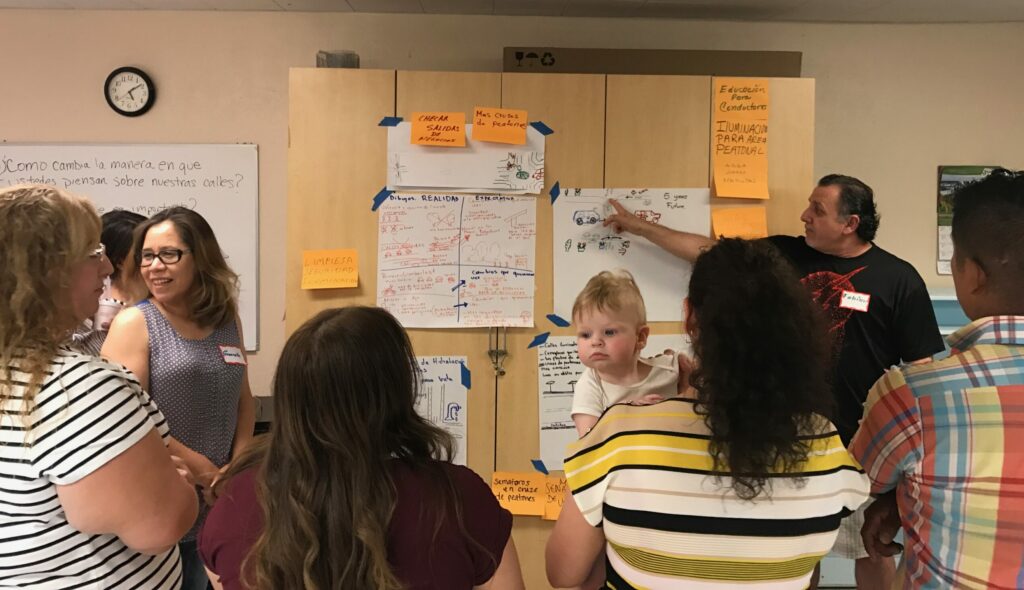
Community members crowd around a cabinet with community traffic priorities during a dialogue session. Photo courtesy of Living Streets Alliance staff.
Part IV: Putting the policy into practice
These labors bore immediate fruit as the paradigm shift to Complete Streets took place. Projects which began just a few months after the policy was passed included design elements shaped by the new mobility priorities for the community outlined in the policy. Which projects overall get advanced has been slower to change, but according to Tucson Complete Streets Program Coordinator Patrick Hartley, the next projects the city undertakes “will be fully conceived and designed with Complete Streets in the forefront.” The three years of nonstop work to craft an impactful policy resulted in strong language that is binding and clear. Engaging with everyone who would have a hand in putting the policy into practice ensured that city staff were able to focus time on implementation and not interpretation.
Due to the specificity of the policy’s plan for implementation, a Complete Streets Program Coordinator, Patrick Hartley, was quickly hired, the CSCC was rapidly set up, and shortly after the city created a design guide for future projects that it then passed in an ordinance.
In addition, by establishing the CSCC in their policy, organizers ensured that an accountability mechanism is built in. There is no need to irregularly summon city agencies and unexpectedly interrupt their work in order to provide testimony or reports to local elected officials. The CSCC collects information about the implementation process and uses it to oversee the responsible agencies, preparing reports on implementation progress every two years.
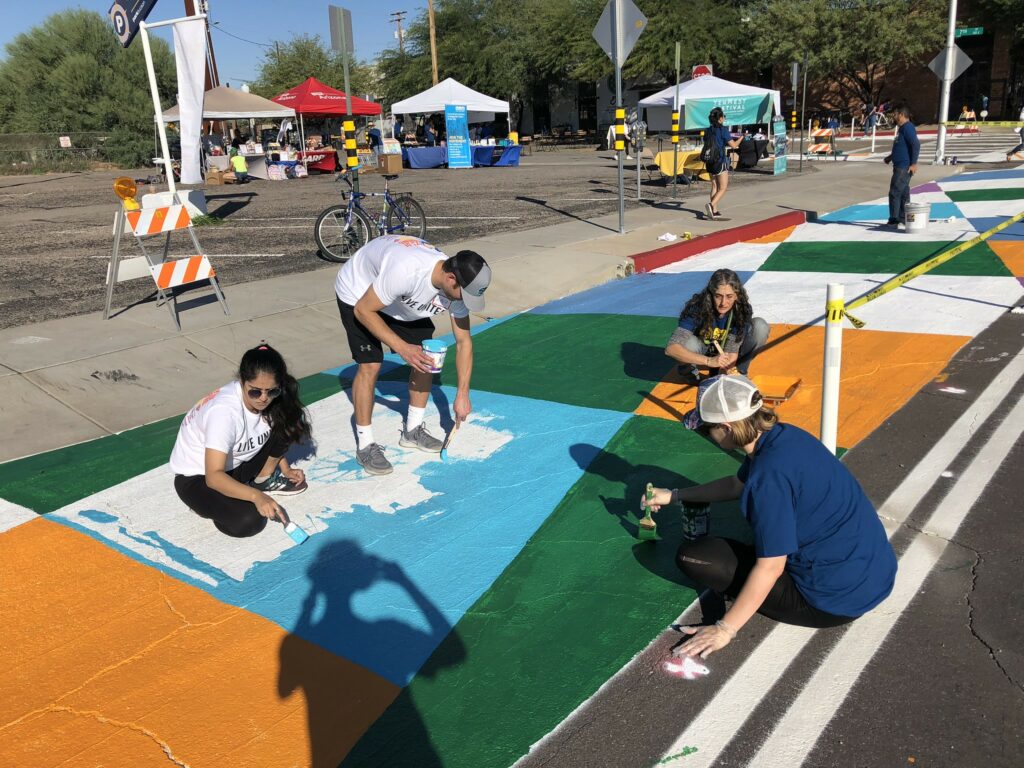
Tucson residents paint the street orange, green, blue, and white during a block party to create a quick-build Complete Streets demonstration project. Photo courtesy of Living Streets Alliance staff.
Project selection criteria and processes were also quickly impacted. In Fall 2021, the city passed its transportation master plan, Move Tucson, which included a list of projects to be funded. Thanks to the Complete Streets policy, the Coordinating Council was involved and potential projects were prioritized using criteria plainly laid out in the ordinance. Organizers’ deliberation ensured that the policy changed not just what was built, but where it was built as well.
Passing a Complete Streets policy did not mean that Tucson’s transportation problems were suddenly solved. In addition to road-widening projects approved in a 2006 ballot measure now beginning construction, some documents required by the policy—such as an implementation plan—haven’t been completed. This means that there aren’t deadlines associated with the tasks outlined in the “Implementation Chart,” which is a potential loss of accountability in the long term. Advocates feel strongly that progress can still continue to be made despite this.
Part V: Lessons learned
Tucson advocates and policymakers understood that Tucson’s community members had critical Complete Streets expertise and that their policy needed to address every aspect of the community, not just its streets.
Community members are experts. The organizers of Tucson’s Complete Streets movement not only engaged community members but treated them as valued participants in the planning process with their own expertise to offer. This is in stark contrast to the typical planning approach, which treats planners and engineers as unimpeachable experts in contrast to community members. By countering this hierarchy, organizers made their policy not only better but likelier to pass.
If it’s not operational, it’s not equity. LSA made sure that equity wasn’t just a goal, but a component of every single process and product. This ensured that, when it came time to write “Move Tucson,” the values in the city’s Complete Streets policy actually turned into planned investments instead of languishing on the shelf.
Complete Streets is about more than pavement. From the start, LSA made clear that Complete Streets is about more than pavement. Organizers believed that what roads look like can’t be disconnected from the social infrastructure around them, nor the processes or people who decide what those roads look like. The inclusion of the elements that described how the built environment impacts the way Tucson residents feel on a day-to-day basis—whether using shade as a metric or mentioning perceived safety and comfort levels—improved the policy and ensured it was sensitive to Tucson’s context in particular.
—
Thank you to Evren Sönmez and Emily Yentman at Living Streets Alliance, as well as Patrick Hartley at the City of Tucson, Arizona, for their time and expertise in producing this case study.